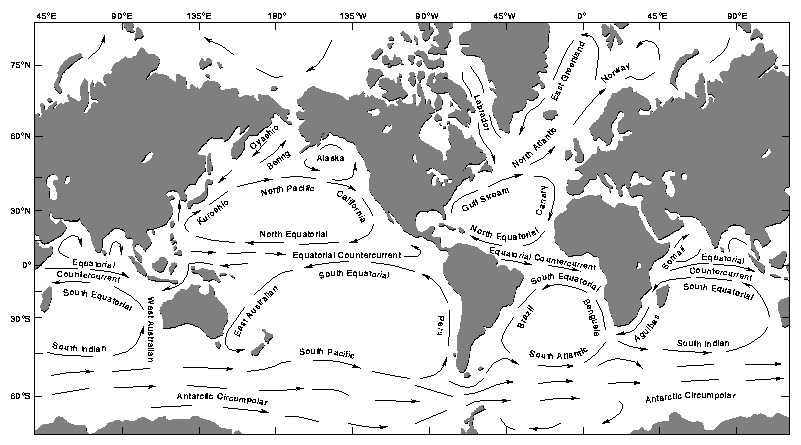
The Major Ocean Currents
As the wind blows across the surface of a body of water, an amazing thing happens: the water begins to move. First, small capillary waves are formed; tiny ripples of waves which appear like a brushstroke across the water's surface. If the wind continues to blow, larger waves appear, momentum is transferred to the water, and the water begins to move. Moving water is subject to the Coriolis effect, just like the wind, and it begins to bend. In the Northern Hemisphere, water is deflected to the right of the direction of the wind; in the Southern Hemisphere, water is deflected to the left. The net effect is that surface currents move at a 45 degree angle to the wind.
Differential heating of the globe is what gives rise to global wind patterns. Because they are persistent, these winds create "permanent" movements of water, which we know as currents. The wind patterns, the Coriolis effect, and the arrangement of landmasses are responsible for large-scale patterns of wind-driven surface currents in the world ocean.
These wind-driven surface currents can be compared and to the density-driven deep water circulation. Surface currents are much swifter and driven by the wind. Density-driven currents are slow, and result from changes in seawater density which occur as a result of temperature and salinity changes. Surface currents are subject to large deflections due to the Coriolis effect; density-driven currents are less influenced by the Coriolis effect because they are so slow moving. Finally, landmasses create barriers to the flow of surface currents whereas the landscape of the ocean floor, especially ridges and basins, impede the flow of deep-water currents.
In general, each hemisphere of an ocean has its own gyre, a circular motion of water. Gyres in the northern hemisphere rotate clockwise and gyres in the southern hemisphere rotate counterclockwise. Let's take a look at these ocean currents and become familiar with their names and movements.

The current that runs southward along our coast is known as the California Current. This current moves cold water from the Gulf of Alaska along our coast and is partially responsible for the relatively cold water we experience when we go to the beach. The California Current feeds into the North Equatorial Current, which heads west along the equator at about 5 degrees N. As this current turns northward, it becomes the Kuroshio Current, which flows along the eastern coast of Japan. As bends east under the Coriolis effect, it becomes the North Pacific Current, which complete the loop.
Another major current feeds off the North Pacific Current in the Gulf of Alaska. This is the Alaskan current which loops northward along the coast of Alaska and flows west along the Aleutian Islands. Another important current in this region is the Oyashio Current, which flows southward from the Bering Straights and converges with the Kuroshio Current before becoming part of the North Pacific Current. Note also that both the Kuroshio and California Currents partially result from the accumulation of water masses driven by the trade winds. Thus, these currents are both wind-driven and gravity-driven, or geostrophic.
South of the equator, the South Equatorial Current draws water from the South Pacific Ocean and flows westward at a latitude of about 5 degrees S, in the same direction as the North Equatorial Current. Note that as a result of the "piling up " of water in the eastern Pacific, another current is formed, the Equatorial Countercurrent, which flows in between the North and South Equatorial Currents and returns water eastward, where it hits the coast of Mexico and diverges to the north and south. This northern divergence, which runs northward along the coast of southern California in a direction opposite to that of the California Current, is known as the California Countercurrent.
As the South Equatorial Current flows westward, it bends south (left) under the influence of the Coriolis effect. Here, it is split into separate flows by the various islands of the South Pacific. Collectively, these currents are known as the East Australian Current because they flow along the east coast of Australia. However, they may assume more regional names based on the landmasses near where they flow. At one point or another, all these currents flow into the West Wind Drift, which circulates around the continent of Antarctica. The West Wind Drift is the only surface current which literally travels around the globe. Along the western coast of South America, the Peru Current flows northward and completes the circulation of the Southern Pacific.
Among physical oceanographers, there is general agreement that the South Pacific Ocean actually consists of two gyres. Because this ocean is so large (the largest, in fact, of all the ocean basins), its currents tend to be slow and somewhat complex. For the purposes of our discussion, we will treat the currents here as one giant gyre, but you should be aware that this treatment is a simplification.